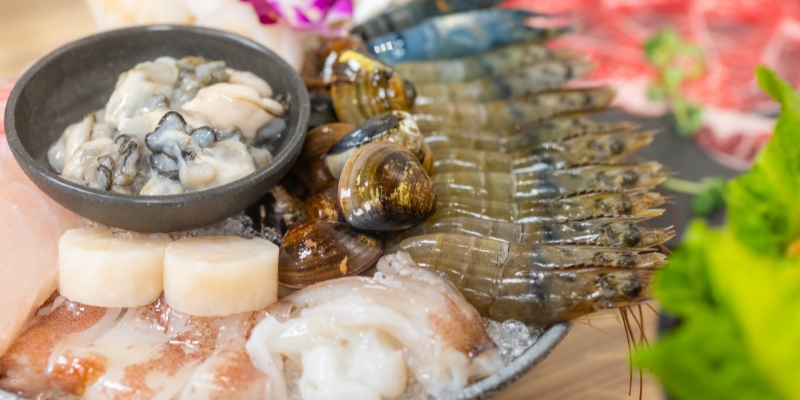A Guide to Mindful Seafood Shopping for a Healthier You
Oct 19, 2023 By Madison Evans
Healthy seafood purchasing is important beyond mealtime. Being filled with lean proteins, minerals, and vitamins, seafood is known for its health advantages. It is famous for its omega-3 fatty acids, which boost heart health, cognition, and more. Sustainable fishing choices help maintain marine habitats and preserve seas for future generations, adding to its many advantages. This article discusses how to choose healthful, ecologically friendly fish.
Understanding seafood's effects may make customers more mindful. Healthy fish provide many nutrients without harming our seas. Shoppers may help themselves and the earth by considering labeling, certifications, sustainability, and ethical shopping.

The Benefits of Eating Seafood:
Before purchasing seafood, you have to comprehend all of its advantages. Seafood is rich in omega-3 fatty acids, crucial for human well-being. Fatty acids lower blood pressure, reduce heart disease risk and improve cognition. Seafood also contains high-quality protein, vitamins B12 and D, and minerals iodine and selenium.
Seafood benefits the environment. Marine conservation may benefit from sustainable seafood. Consumers may safeguard endangered species, limit overfishing, and promote marine ecosystems by choosing ethically harvested or farmed seafood. Thus, seafood may be consumed healthily while preserving these resources. This win-win situation benefits people and the earth.
Understanding Seafood Labels and Certifications:
Seafood labels and certifications might be confusing, but they are essential to ethical seafood purchases. These badges indicate quality, safety, and sustainability. Marine Stewardship Council accreditation is well-known. Seafood certified by MSC comes from well-managed, environmentally friendly fisheries. The Aquaculture Stewardship Council (ASC) certifies ethically produced fish, ensuring environmental and social compliance.
Organic seafood labels specify that the product was farmed without synthetic additives and in an ecologically responsible manner. Third-party certifications like the Global Sustainable Seafood Initiative (GSSI) mark compliance with sustainability standards. Consumers should comprehend these labels and certifications to make educated decisions. These marks help buyers choose healthy, environmentally friendly seafood.
Selecting Sustainable Seafood:
Choose sustainable seafood to protect marine habitats and our seas. Certain seafood is sustainable, whereas others are overfished or ecologically detrimental. Sustainable seafood purchasing involves picking plentiful, non-depleted species. Due to good management, farmed tilapia, Alaskan salmon, and Pacific sardines are sustainable.
Avoid seafood from overfishing, habitat devastation, or destructive fishing techniques. Avoid overfished species like bluefin tuna and Chilean sea bass to encourage responsible consumption. Seafood retailers and marketplaces are giving more sustainability information. The Seafood Watch app and Good Fish Guide let customers easily evaluate species sustainability. Buying seafood responsibly helps preserve seas for future generations.
Seafood: Fresh vs. Frozen
Seasonality, accessibility, and convenience might impact fresh or frozen fish selection. Fresh fish is praised for its instant availability, especially in coastal areas or large seafood markets. Fresh seafood's apparent advantage is occasionally untrue. Much of the "fresh" seafood sold at the counter has been frozen at sea and thawed. Ask about seafood origin and processing to maintain freshness.
However, frozen fish has several benefits. Since seafood is frozen soon after capture or harvest, it retains flavor and nutrients. This quality lock-in assures optimal seafood freshness when cooked. Due to its extended storage life, frozen fish offers more variety and reduces food waste. Fast-frozen fish is usually better-tasting and more nutritious. Health-conscious customers may trust frozen seafood if properly stored and handled.

Shopping at the Fish Market or Supermarket:
Fish market and supermarket seafood shopping provides distinct options. A fish market lets you talk to professional fishmongers about the day's catch and suggest the finest options. Your fishmonger may give storage, preparation, and recipe advice if you get to know them. Bright, clear eyes, lively skin, and a clean, ocean-like scent indicate fresh seafood at the market.
Many buyers find frozen and fresh fish in handy supermarkets. Check store seafood labels for origin and sustainability. Seafood departments increasingly disclose sourcing and sustainability practices. Asking questions and making educated choices may help you choose seafood that satisfies health and environmental requirements.
Cooking and Preparing Seafood:
After buying healthy seafood, how you cook it might affect the outcome. Fish may be grilled, baked, steamed, or poached to maximize flavor and nutrients. Use seasonings, herbs, and spices to make your recipes more creative and enrich the eating experience.
Avoid overcooking fish, which may dry or rubberize it. Many seafood alternatives are adaptable to many cuisines. New recipes and methods may make cooking fish fun and gratifying. The health benefits and flavors of seafood may be enjoyed entirely with correct cooking.
The Role of Education and Advocacy:
Conscientious seafood shopping extends beyond personal preference. Promote sustainable seafood practices through raising awareness. Sharing information with friends, family, and the community may inspire responsible decisions. Another strategy to improve industry practices is encouraging restaurants and marketplaces to offer sustainable seafood. Supporting sustainable businesses increases demand for responsible seafood.
Online tools and applications may help you make sustainable decisions. The Monterey Bay Aquarium's Seafood Watch app updates you on the finest seafood options, helping you keep up with industry trends. Sustainable seafood advocates improve the earth and inspire others.
The Power of Diversity:
Diversifying seafood intake is healthy and sustainable. Explore new seafood species to discover new flavors, textures, and cuisines. It also eases species pressure, protecting marine ecosystems. Celebrate seafood variety for taste and sustainability.
Choose sustainable seafood to safeguard our seas and marine life and improve your health. Choosing numerous and well-managed species helps marine conservation, guaranteeing healthier seas for future generations. Fresh and frozen fish have different benefits and may be used in different recipes. Proper cooking and preparation maintain seafood's health advantages, making every meal delicious. Your knowledge, activism, and support for variety may also strengthen the demand for ethical seafood and improve the earth.
Conclusion:
Finally, purchasing nutritious seafood involves personal health, environmental responsibility, and gastronomic enjoyment. Seafood's nutrition and sustainability make it vital to a balanced diet. Shopping for seafood with an understanding of labels and certifications supports quality, safety, and environmental health.
Choosing sustainable seafood is healthy and protects our seas and marine life. Shoppers can preserve seas for future generations by picking plentiful and well-managed species. Fresh and frozen fish have different advantages and may be used in different recipes. Finally, correct cooking and preparation retain seafood's nutritional advantages and make every meal enjoyable. We improve our health and the world by shopping for seafood.








